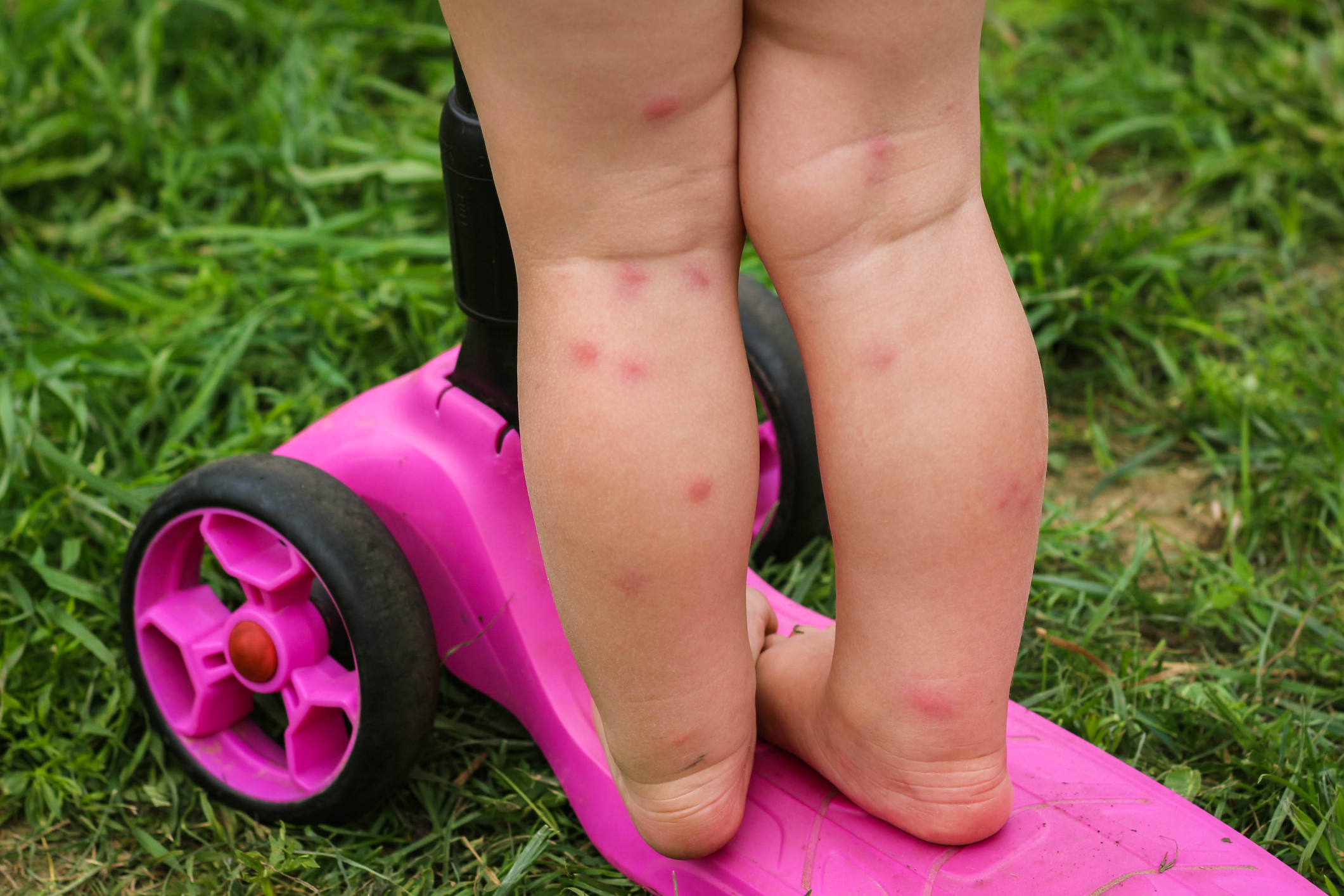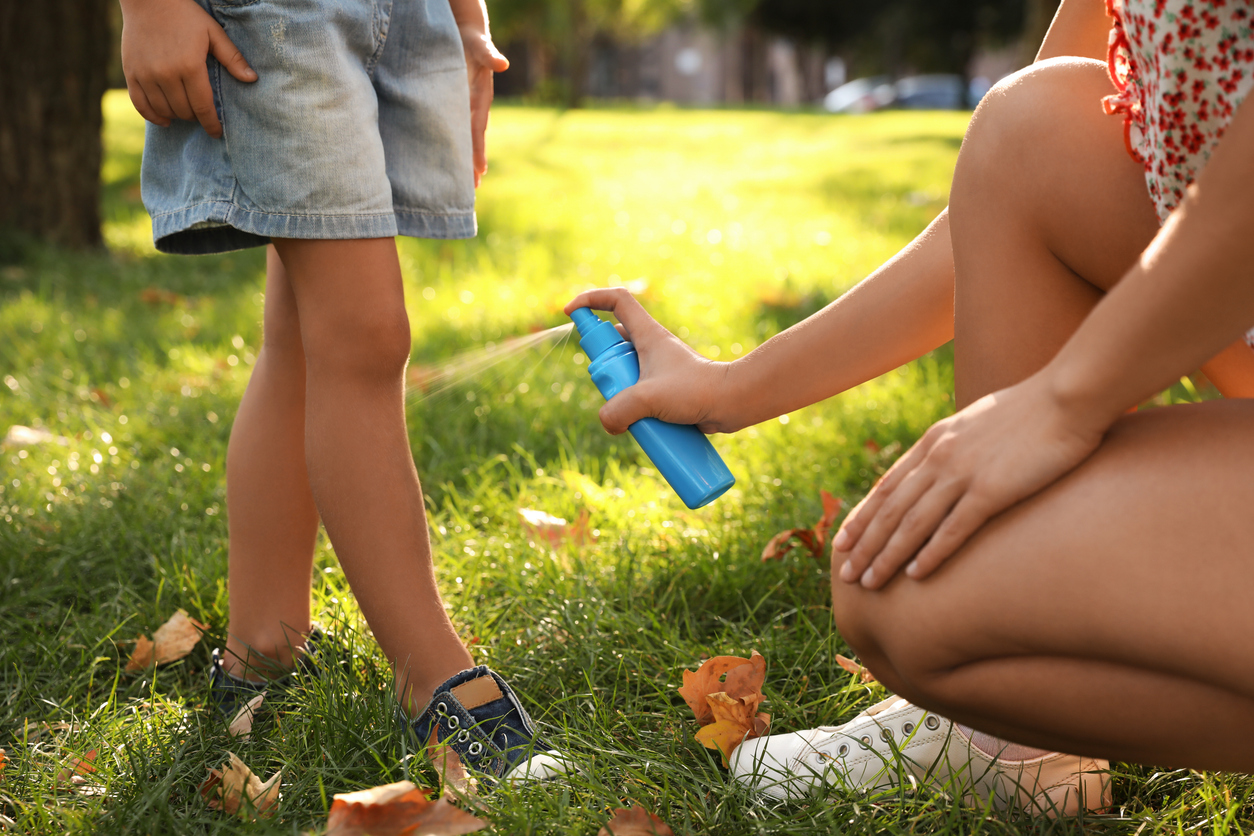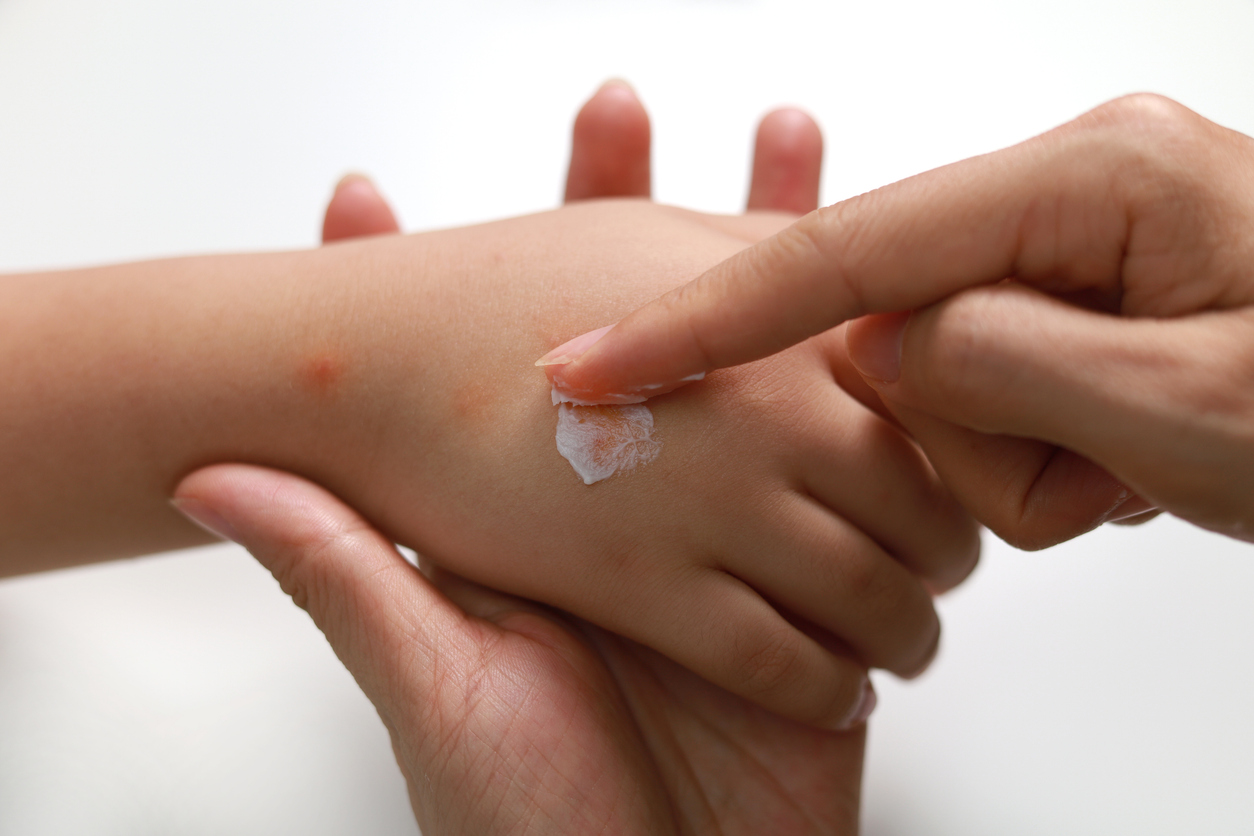As warmer weather arrives and outdoor adventures begin, so does the risk of encountering various insects. At Blueberry Pediatrics, we believe in preparing you with the right information to handle these minor inconveniences confidently. Here's everything you need to know about preventing, treating, and understanding when a bug bite might require a pediatrician's attention.
Key Takeaways:
- There are many insect bites; most present only minor symptoms, but knowing the appropriate treatment and potential risks will help avoid serious complications.
- While bites can't be prevented altogether, using insect repellent and staying indoors during peak biting times can help avoid bug bites and potential complications.
- Treatment for bites and stings typically includes washing the area with soap and water, applying a cold compress, and applying over-the-counter medications like calamine lotion or diphenhydramine (Benadryl) cream to relieve itching.
Types of insect bites and stings

Identifying the type of insect responsible for a bite can be crucial for determining the appropriate treatment and understanding any potential risks. Here are some common culprits and what you might expect from their bites:
Mosquitoes
These are the most common biters, known for leaving itchy, round, or like hives and red bumps that may appear minutes after the bite.
Ticks
Tick bites are painless, but these insects can remain attached to the skin for a long time. Some specific ones in certain areas are known carriers of diseases like Lyme disease and Rocky Mountain spotted fever.
Bees and Wasps
These insects' stings are painful red and can cause significant swelling. Some individuals may have a severe allergic reaction, such as anaphylaxis, which is life-threatening requiring immediate medical attention.
Ants
Fire ant bites can be painful and burn, often resulting in raised red welts that develop into pimples. Non-fire ants typically cause minor irritation and slight swelling.
Spiders
Most spider bites are harmless with minimal symptoms, but some kids can react like a bee sting reaction. Be careful because bites from species like the black widow or brown recluse can be serious and require medical care. A brown recluse spider bite necessitates immediate medical attention due to the risk of serious reactions.
Fleas
Though they are quite a nuisance, these bites usually appear as small red bumps clustered around the legs or ankles, which are intensely itchy and may bleed from scratching. Flea bites can transmit diseases like the plague, so addressing them promptly is important.
Chigger bites
They are painless but usually group in an area like the waistline or legs. Chigger bites occur when mites inject their saliva into the skin, causing intense itching and inflammation that can last for days or weeks.
<div fs-richtext-component="cta" class="content_cta">
<div class="content-cta__title">
<div class="y-tex-xxs text-color-white">
Blueberry - Rated best for online pediatrics!
</div>
</div>
<div class="y-text-2xl text-color-white">
👩🏽⚕️ Chat With A Pediatrician About Your Child's Symptoms
</div>
<a href="https://app.blueberrypediatrics.com/join_blueberry_18a_cart?promo=blog100"
target="_blank" class="content-cta_btn w-button">
Get Started
</a>
<link rel="prefetch" href="https://app.blueberrypediatrics.com/join_blueberry_18a_cart?promo=blog100">
Why do insects bite?
Knowing what attracts insects may help you take proactive steps to make yourself and your children less appealing to them. Some common reasons insects might find you or your child appealing:
- Body heat and moisture: Many insects are drawn to the heat and sweat the human body naturally emits. This is particularly true for mosquitoes using thermal sensors to locate their next meal.
- Carbon dioxide: Every time you exhale, you release carbon dioxide. Insects like mosquitoes are highly sensitive to CO2 and can detect it from a considerable distance.
- Body odors: Bacteria on your skin interact with sweat to produce body odor. Certain smells can attract insects, while others may repel them. This is why personal hygiene and certain scented products can influence insect attention.
- Color and movement: Bright colors and rapid movement can attract insects such as bees and wasps, especially to floral patterns and activity that might indicate flowers.
- Light: Many flying insects are attracted to light so you may notice more bugs around outdoor lights in the evening.
How to prevent bug bites

The best way to deal with bug bites is to avoid them in the first place. Here are some ways to keep the bugs at bay.
Dress for safety
Whenever heading outdoors, especially in areas with tall grass or woods, dress your child in a hat, long sleeves, pants, and socks. Tucking shirts into pants and pants into socks can offer extra protection.
Treat your clothes
Permethrin is an insecticide that treats clothing and gear (this one does not go on the skin), making it bug-repellent. Treated clothing can stay protected for several washes.
Use the right repellent
Apply an insect repellent that contains 10-30% DEET, picaridin, or oil of lemon eucalyptus. If using Eucalyptus, it must have less than 30% concentration and only apply it to those older than three years old. Be sure to follow the application instructions on the label for safe and effective use. It is not recommended to use sunscreen and insect repellent combo products.
Stay indoors during peak times
Stay indoors during dawn and dusk, which are peak biting times for insects like mosquitoes.
Eliminate breeding grounds
Get rid of any standing water that could be a breeding ground for mosquitoes. This includes old tires, buckets, planters, and anything else that can hold water.
Check After Outdoor Time
Use proper repellants and personal care to prevent tick bites. It is important to check your child's body every night with a bath after spending time in bushes, high grassy, or wooded areas - paying close attention to the area behind their knees and in every crease that can hide them.
Bug spray safety tips and warnings
Bug sprays and other repellents can pose risks, especially in children. Here are some safety tips:
- Don't apply over large areas of skin: Focus on exposed areas and avoid applying near eyes or mouth.
- Follow label directions: Always adhere to the application instructions to avoid overuse or misapplication.
- Choose kid-safe products: Select repellents approved for Your child’s age and choose those with lower DEET concentrations, whenever possible.
- Consider alternative repellents: Look for repellents containing picaridin, oil of lemon eucalyptus (not to be used by children under 3 years of age), or IR3535 (for all ages), which may be gentler on skin.
- Wash hands after application: Ensure your child washes their hands after applying repellent to avoid contact with eyes or mouth.
Bug spray: things to consider
In some cases, bug spray can cause adverse side effects. Keep the following in mind when applying insect repellent to your child:
- Skin irritation: Some ingredients, like DEET, can cause skin irritation, redness, or a rash, especially with prolonged use or high concentrations.
- Accidental ingestion: Swallowing bug spray can be dangerous, especially for children or pets. Symptoms can range from mild nausea to seizures, so seek help from medical professional/and poison control for help.
- Nervous system effects: High exposure to some repellents, particularly DEET at high concentrations more than 30%, can cause neurological problems in rare cases.
- _ maybe move the no repellant with sunscreen here - sunscreen needs reapplication more often than what is safe for repellant.
How to treat bug bites

Even with the best preventive measures, bug bites can still happen. Here are quick and effective ways to treat them:
- Clean and Soothe: Wash the affected area with soap and water and apply a cool compress or ice pack to reduce itching and swelling.
- Use Appropriate Medications: Over-the-counter treatments like hydrocortisone, Benadryl cream, or calamine lotion can provide relief. For severe itching, oral antihistamines, stronger topical or oral corticosteroids, or antibiotics might be necessary.
- Avoid Scratching: Encourage your child not to scratch the bite, which can increase the risk of infection.
Treating tick bites
If you discover a tick on your child's skin, carefully remove it using fine-tipped tweezers by grasping it close to the skin and pulling straight upward with gentle, steady pressure; avoid crushing the tick. (Take a picture or save the tick in case you need to refer back to it during a medical appointment)
After removal, cleanse the bite area with soap and water, then disinfect it with rubbing alcohol or an iodine solution. Keep an eye on the bite area for signs of infection like redness, swelling, or pus.
Remember the date of the tick bite and watch for symptoms of tick-borne illnesses, such as Lyme disease, in the weeks and months ahead. Consult a doctor if you notice any worrisome symptoms.
Complications from bug bites
While most bug bites are harmless and only cause temporary discomfort, some can lead to more serious health issues. Potential consequences of an insect bite or sting are serious medical conditions, allergic reactions, skin infections, and the transmission of diseases.
Potential insect bite complications and what to expect
Lyme Disease
Often transmitted by deer ticks, this can cause symptoms ranging from rash and fatigue to serious neurological and joint issues if left untreated.
- Babies and Toddlers: Symptoms in young children can be more subtle, such as fever, irritability, and body aches that they may not be able to articulate. Lyme disease can also cause a characteristic bull’s-eye rash, which parents should watch for.
- Adolescents/Teenagers: Older children are more likely to engage in outdoor activities where ticks are prevalent. They might experience symptoms similar to adults, including fatigue, joint pain, and neurological issues if the disease progresses.
West Nile Virus
Carried by mosquitoes, this virus is mostly asymptomatic but can lead to severe symptoms like high fever, headache, neck stiffness, disorientation, and in rare cases, neurological diseases.
- Babies and Toddlers: This group is particularly at risk as their immune systems are not fully developed. While infections are often asymptomatic, severe cases can lead to neurological complications like encephalitis (inflammation of the brain).
- Adolescents/Teenagers: They might experience flu-like symptoms that can escalate to more severe forms, though such cases are relatively rare.
Rocky Mountain Spotted Fever
Transmitted by ticks, this bacterial infection can be serious if not treated early. Symptoms include fever, rash, bleeding, headache, abdominal pain, vomiting, and muscle pain.
- Babies and Toddlers: Young children are more likely to develop severe forms of the disease, which can be life-threatening if not treated promptly. Symptoms include high fever, swelling, rash, and vomiting.
- Adolescents/Teenagers: Symptoms are similar to those in adults and include fever, rash, and severe headache. Early antibiotic treatment is crucial.
Zika Virus
Another mosquito-borne virus that has been linked to birth defects when pregnant women are infected. While symptoms are generally mild, its effects on pregnancy are significant.
- Babies and Toddlers: While most Zika infections are mild, the greatest risk is to fetuses during pregnancy. However, a congenital Zika syndrome can result in severe birth defects, developmental issues, and neurological conditions.
- Adolescents/Teenagers: For teenagers, especially pregnant teens, Zika can pose significant risks to the unborn child, including microcephaly and other congenital anomalies.
Allergic Reactions to Bites or Stings
Some individuals may experience severe allergic reactions to insect stings, particularly from bees, wasps, or ants, which can result in anaphylaxis—a life-threatening condition that requires immediate medical attention.
- Babies and Toddlers: Young children may have more pronounced reactions to insect stings or bites due to their smaller body size, which can lead to rapid onset of symptoms like swelling, vomiting, diarrhea and difficulty breathing.
- Adolescents/Teenagers: This age group may be more likely to engage in activities that expose them to stinging insects. While many can handle bites and stings without severe complications, allergic reactions can be dangerous and require immediate medical attention.
Given these risks, be vigilant in checking your children for bites, monitoring for unusual symptoms, and seeking medical attention when necessary. This ensures timely treatment and reduces the risk of serious health issues related to insect bites.
When to see a doctor
Most bug bites are harmless and annoying, but some can cause more severe reactions or carry diseases. See a doctor if your child experiences:
- Signs of infection: Increasing redness, swelling, pus, yellow crusting, or if the bite area feels warm to the touch.
- Allergic reactions: Symptoms like difficulty breathing, swelling of the face or lips, or hives.
- Concerns about spider or tick-borne diseases: Certain ticks and spiders can transmit diseases, making prompt medical attention crucial.
- Worsening symptoms: If the bite site worsens after a few days of home care, it's best to see a doctor to rule out infection or other complications.
- Unusual bite: If the bite appears unusual or different from a typical insect bite, a doctor can help diagnose the cause and recommend treatment.
- Bite near the eyes or mouth: Bites in these sensitive areas can be more serious and require medical evaluation.
Concerned about a bite or your child's reaction to one? The board-certified pediatricians at Blueberry Pediatrics are just a call or click away. Blueberry offers unlimited virtual healthcare right from the comfort of home. Our experienced doctors can assess the bite and provide personalized treatment recommendations, saving you time and worry. Our pediatricians are available 24/7/365 via text, phone, or video - no appointments or long waits. Plus, you can see a doctor as soon as you join; sign-up takes just minutes!
.png)
Sources
- Bug bites and stings. (n.d.). Www.aad.org. Retrieved May 9, 2024, from https://www.aad.org/public/everyday-care/injured-skin/bites
- CDC. (2020, December 2). Mosquito Bites | CDC. Centers for Disease Control and Prevention. https://www.cdc.gov/mosquitoes/mosquito-bites/index.html
- Insect Bite. (n.d.). Seattle Children’s Hospital. https://www.seattlechildrens.org/conditions/a-z/insect-bite/
- Stiepan, D. (2021, June 29). “The bugs are out,” Tips on how to get through bug-biting season. Mayo Clinic News Network. https://newsnetwork.mayoclinic.org/discussion/the-bugs-are-out-mayo-clinic-expert-offers-tips-on-how-to-get-through-bug-biting-season/
- Identifying Insect Bites and Stings. (n.d.). HealthyChildren.org. Retrieved May 9, 2024, from https://www.healthychildren.org/English/health-issues/conditions/from-insects-animals/Pages/Identifying-Insect-Bites-and-Stings.aspx
- How to Remove A Tick. (n.d.). HealthyChildren.org. https://www.healthychildren.org/English/health-issues/conditions/from-insects-animals/Pages/How-To-Remove-A-Tick.aspx
- Choosing an Insect Repellent for Your Child. (n.d.). HealthyChildren.org. https://www.healthychildren.org/English/safety-prevention/at-play/Pages/Insect-Repellents.aspx
Frequently Asked Questions
Are spider bites dangerous?
Most are harmless with minimal symptoms, but bites from a black widow spider or brown recluse spider can be serious and require medical care.
Can bug bites cause a skin infection?
Yes, bug bites can cause skin infections if the area is not properly treated. Monitor your child's bites for signs of infection, such as fever, redness, swelling, or pus. If you notice these symptoms, seek medical attention immediately.
What should I do if my child gets a tick bite?
Tick bites can sometimes transmit diseases such as Lyme disease, so removing the tick as soon as possible is important. Use tweezers to grasp the tick as close to the skin as possible and pull straight out with steady pressure. Then, clean the area with soap and water and watch for any symptoms of illness in your child.
How can I prevent insect bites?
Here are five steps to prevent insect bites:
- Avoid areas with high insect activity, such as standing water or heavily wooded areas.
- If your child will be playing outside, dress them ina hat, long sleeves and pants to minimize exposed skin.
- Apply insect repellent specifically designed for children and follow the instructions carefully.
- Consider treating clothing and gear with permethrin, which repels insects on contact.
- Daily check for any hiding insects on your child's body after spending time outside.
What causes reactions to bites and stings?
Reactions to bites and stings are caused by the body's immune system responding to the insect's venom or saliva. For most people, these reactions are mild and include redness, swelling, and itching at the site of the bite or sting. However, some individuals may experience more severe allergic reactions.








.svg)






.svg)
.svg)